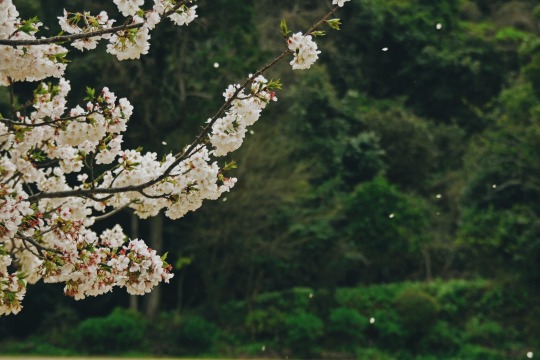#唐
Text
何故、中共は「中国4000年の歴史」とか「中華民族」とか見えすいた嘘を吐くのか?侵略の準備なんだよ!
本当は夏朝、殷、隋、唐、金、遼、元、清など全て騎馬民族など異民族支配で元々の漢民族は殆ど後漢で滅んでる
その王朝でも支配してたのは北京周辺であり今のチベット、内モンゴル、ウイグルなどの地域も異民族に支配されており、北京周辺王朝は貢いでたり、王族などから女を贈って、勘弁して貰ってた
女を贈って置いて「あの地方王朝の王は俺たちの婿様だから、あそこも中華王朝の一部」とか無理な事を言ってる
しかし中共はその論理でチベットを盗り、内モンゴルを裏切り、東トルキスタン(ウイグル)を強奪して、中共から人を沢山送り現地人をレイプ強姦して妊娠させ混血児を増やし、現地人には強制堕胎、強制不妊手術を行い純粋な現地人人口を減らし、言葉を奪い、文化や宗教を禁止して文字通り民族浄化して、根絶やしにしようとしている
「元々は中華の一部」「太古より中華民族(なんだソレ?)が住んでた」と言い張り、侵略している
同じ論理をプーチンがウクライナに言って「元々はロシアの一部」「昔からウクライナにもロシア人が住んでた」と言い張り、ロシア系住民保護と主張して、ウクライナに侵攻した
おんなじパターン
中共は「尖閣は中共の土地」「沖縄は中国(どの支那だよ?)に朝貢してた中国の一部」と主張している
北海道には沢山、移民させてる
次はどうなるかって?
そりゃ中共による尖閣、沖縄、北海道の侵略が始まるんだよ!
だから「中国4000年の歴史」とか「ずっと中国はあった」とか「偉大な中華民族(何ソレ?)」という嘘に加担しては駄目だ!
それは彼らの宣伝
それは彼らのプロパガンダ
なんだよ?
欧米なんか知ってか知らずか
鵜呑みにしてる
日本国民は洗脳されて
鵜呑みにしてる
まずそこを否定して
防衛強化して
教育を強化して行こう!
【関連】
828 :本当にあった怖い名無し :sage :2010/09/27(月) 12:12:24 ID:fsTA3r1B0(4)
支那人にも孔子、老子、孟子を生んだ立派な文明があると誤解している日本人が多いのだと思います。
漢文を通じて中国人を理解することぐらい、絶望的な行為はありません。何故なら漢文はこの二千年間というもの中国語とは全く関係がない。日本人のほとんどは漢文を中国語の古語と思ってきたのです。
つまり日本人が尊敬し 知っている漢民族は紀元二世紀でこの地球上から姿を消し、中国住民はそっくり北方の騎馬民族の子孫に何回も何回も入れ替わってしまったのです。
そして秦や漢時代の中国人は,そのほとんどが大陸から居なくなったということです。
ところが日本は遣隋使や遣唐使たちの使節が派遣され膨大な漢籍を大陸から持ち帰り,それを今日まで途切れることなく勉強してきたのです。
つまり日本人は騎馬民族の子孫である中国でなく2000年以上前のいなく なった漢民族の文化を勉強してきたのです。
日本人なら誰でも知っている儒教の開祖である孔子は,紀元前6~5世紀 中国各地の有力諸侯が覇権を争っていた春秋時代のことです
830 :本当にあった怖い名無し :sage :2010/09/27(月) 12:13:38 ID:fsTA3r1B0(4)
使節団が中国から持ち帰った無数の漢籍を日本人は今日まで約1300年間も読み込んできたのです。
早い話が遣隋使や遣唐使が持ち帰った「論語」や「漢詩」などによって 皮肉なことに中国人でなく日本人の人格が磨かれてきたのです。
中国語と漢文は全く関係がない、つまり漢文の読めない中国人にとって孔子や孟子の教えなど身につくはずもありません。
いわゆるこの二千年間というもの,漢文は中国語とは全く関係がないと いうことを多くの日本人は知らなかったのです。
私はこれらのことを中国史研究の第一人者である岡田英弘先生から教えてもらいました。
私も20年前 漢文を通じて身につけた中国イメージのまま中国に進出してそのギャップの大きさに仰天した記憶があります。
中国進出する前は、信義に厚く,礼を尊ぶ文化人の国であると信じていました。しかし現実にいるのは,油断も隙もならない、詐欺師の野蛮人ばかりでした。
中国人に取って漢文とは外国語同然なのです.中国で話されている言葉とは全く無縁の言語体系なのです。
831 :本当にあった怖い名無し :sage :2010/09/27(月) 12:14:22 ID:fsTA3r1B0(4)
現在の中国人は,彼らが使っている中国語が,実は文体もボキャブラリーも日本語からの借用であるということを隠そうとしています.現代日本文の真似をして前置詞や助動詞を明確に記すことによって、やっと文章が書けるようになったのです。
日清戦争後,日本に大量の清国留学生がやってきて,日本語を学び中国語を誰でもが読める中国語の表記法を改良していったのです.その中にかの有名な魯迅もいたのです。
日本語をマスターした魯迅の頭の中は日本語の文章があり,それを漢字に置き換えて表現することによって原文一致体の「白話文」が生まれました。
そして試行錯誤の結果 現在における中国語は北京語を元にした「普通話」がやっと確立されたのです。
つねに色んな異民族に取って変わられた中国の歴史を眺めたとき,中国政府が宣伝している四千年の歴史は中国人の歴史ではなく中国大陸の歴史だということがわかります。
中国には単一民族としての中国人は一度も存在しなかった.中国語には
北京語,上海語,福建語などの言葉があることを知られていますが、実際はもっと言語は細分化されています。これらは単なる方言というのでなく,ほとんど共通点がありません。
そこで中国政府は各国が持っている「国民国家」というシステムを作るために国民を北京語に統一して教育してきたのです。それもまだ100年足らずのことです。
833 :本当にあった怖い名無し :sage :2010/09/27(月) 12:16:10 ID:fsTA3r1B0(4)
そして言語だけでなく異文化、異言語の人々の寄せ集め集団である中国を統一するために歴史も歪曲せざるをえなかった。
毛沢東は少数民族を含めて全ての中国人を漢族にしてしまうために少数民族の文化を奪い、抵抗するものは容赦なく抹殺してきたのです。
もし少数民族の自治や、言論の自由といったものを実現させれば、中国政府が意図する最強の「国民国家」システムの改造計画が頓挫してしまいます。
この中国共産党の意図が理解できたとき、日本人やアメリカ人が思っている「中国は資本主義開放経済への道を進めば自然に民主国家になっていく」という考えが いかに愚かな事であるかということがわかっていただけたとおもいます。
http://2nnlove.blog114.fc2.com/blog-entry-2836.html
403 notes
·
View notes
Photo

✿ 唐果物
#唐果物#日本:唐#日本:唐くだもの#wagashi#日本:2020〜#日本:和菓子#和菓子#日本#唐くだもの#御くだもの#御果物#からくだもの#唐#日本:平安時代#history:日本#平安時代#2020〜
12 notes
·
View notes
Quote
彼も人なり、我も人なり
[由来] 八~九世紀、唐王朝の時代の文人、韓かん愈ゆの文章の一節から。昔の人は、舜しゅんという聖人の話を聞くと、「彼も人なり、予われも人なり(その人も私も同じ人間だ)」と考え、自分も舜のようになろうと朝晩、努力したものだ、と述べています。また、この一節の元になったものとして、「孟子―滕とうの文ぶん公こう・上」に出て来る、「彼も丈夫なり、我も丈夫なり(その人もいっぱしの男なら、私だっていっぱしの男だ)」があります。
彼も人なり、我も人なり(かれもひとなり、われもひとなり)とは? 意味や使い方 - コトバンク
0 notes
Text
緊急電:イスラエルvsハマス、すでに人質一部が解放済み!西側メディア!それはよかった!
なーははは!By小五郎なんてな?だが同時にこれだけは言えんの。さ。「北」による拉致。釈放の条件は確実に上がった。外交という力量の差。「北」は無制限に言いよるやろね。もう。こうなったらよね。まあ、日本にとって見たら最悪のなんとかやろね。パレスチナの「朝貢」は、なんとCCPへ。しかも、にわか「唐」「隋」ブーム?やってもうた?あちゃあ。反面教師とは?「唐」「隋」、踏みつぶしたろ?逆に??踏みつぶされた、、、?
0 notes
Text
唐朝女皇武則天越窯秘色青瓷浮雕鳳(女皇)霸臨天下紋筆洗
Tang Dynasty Empress Wu Zetian Yue Kiln Secret Color Celadon Relief carved Phoenix (Empress) dominating the world Brush Washer
https://youtu.be/HHsfyAlKONo
https://youtu.be/PPFJeQOtgI8
https://youtu.be/JcU8iyQhK5w
https://youtu.be/zigAXiy2ERo
https://youtu.be/yfyygfTn3tM
https://youtu.be/68e755vWA7g
https://youtu.be/m9Ux4vcwXAY
https://youtu.be/aFi1rm3IfQI
https://youtu.be/tD4v92jon2o
https://youtu.be/vCb60qelr04
https://youtu.be/sRzqH_NOs6U
https://youtu.be/pebzMAciR4M
https://youtu.be/34bteIk8Udc
https://m.facebook.com/groups/fine.art.to.sell/permalink/3236331590022555/
https://www.facebook.com/groups/fine.art.to.sell/permalink/3237582189897495/
https://www.facebook.com/groups/fine.art.to.sell/permalink/3233790350276679/
https://www.facebook.com/groups/fine.art.to.sell/permalink/3233786293610418/
https://www.facebook.com/groups/fine.art.to.sell/permalink/3233784463610601/
https://www.facebook.com/groups/fine.art.to.sell/permalink/3227831320872582/
唐朝女皇武則天越窯秘色青瓷浮雕鳳(女皇)霸臨天下紋筆洗
尺寸:高 5.1 - 5.2 x 最大圓腹徑 25.2 - 25.4 x 口徑 20.7 - 20.8 x 圈足底徑 21.1 - 21.2 cm 公分
此筆洗堪稱為唐代「帝國重器」,其工藝、尺寸、浮雕紋飾、器型、全器表面溫潤如玉器、浮雕如玉雕、全器滿釉呈現清徹光亮滑順光澤、聚釉處晶亮光澤如冰面,秘色青釉等皆遠勝於其未來 1,300 年內,五代後周世宗柴榮帝柴窯筆洗,宋朝皇帝徽宗汝、官、哥、定、鈞五大名窯筆洗,明朝永樂、宣德青花筆洗,甚至於遠超過清三代康熙、雍正、乾隆朝帝王單色釉筆洗。
此筆洗也因具備越窯秘色青瓷浮雕鳳(女皇)霸臨天下紋飾,且釉色為唐代初期的「青泛黃」,全器滿釉,器底圈足內有七個「灰白色豆狀」支燒釘泥點印痕,全器溫潤明亮脂狀光澤類似玉雕品,明顯為越窯進貢唐朝皇室貢瓷,臣民不得使用,據此推論應屬唐朝女皇武則天 (公元 624 年 - 705 年) 之筆洗重器。
此筆洗又因具備有喻意「延年益壽」的「鶴紋」,據此推論應屬唐朝女皇武則天晚年自立為武周皇帝 (公元 690 年 - 705 年) 時之越窯向唐朝皇室祝壽貢瓷筆洗重器。
越窯是唐朝、五代時浙江紹興越州的瓷窯,窯址主要分佈於慈谿的上林湖一帶。隋朝、唐朝時紹興叫「越州」,因此得名為「越窯」。越窯燒製的青瓷器在唐代很出名。
越窯是中國聞名遐邇的青瓷窯之一。越窯青瓷是中國最久遠的瓷器之一,是世界公認的「瓷母」。
越窯燒造瓷器歷史悠久,從西周原始瓷到唐宋秘色瓷,從未間斷,唐代越窯青瓷成為皇室貢品。
唐詩人陸龜蒙用「九秋風露越窯開,奪得千峰翠色來。」讚美越窯青瓷的典雅秀美,對其釉色清澈碧綠、如冰似玉的光澤,給人以一種捉摸不定的感覺,譽稱為「秘色瓷」。
唐代陸羽在《茶經》中寫道:「碗,越州為上。其瓷類玉、類冰。」。
晚唐、五代時最上品的越窯千峰翠色青瓷專門作為皇室貢品,臣民不得使用,因此稱為「秘色青瓷」。
五代時閩國王王審知曾派徐夤貢秘色瓷,徐夤作詩:《貢余秘色瓷器》:「捩翠融青瑞色新,陶成先得貢吾君。功剜明月染春水,輕旋薄冰盛綠雲。
古鏡破苔當席上,嫩荷涵露別江濆。中山竹葉醅初發,多病那堪中十分。」。
宋朝趙彥衡《雲麓漫鈔》說越窯秘色瓷艾色,又引唐代詩人陸龜蒙《進越器詩》曰:"九秋風露越窯開,奪得千峰翠色來;好向中霄盛沆瀣,共稽中散斗遺杯。」。
1987 年 4 月 3 日,法門寺真身寶塔的地宮被打開,出土大量珍貴文物,其中包括十三件秘色瓷器,現存法門寺博物館。
越窯器物燒製,凡是在外底有泥點支燒印痕的器物,定是無匣明火迭燒,其時代可以早到初、盛唐時期,晚至北宋元祐、政和時期。
在初、盛唐時期,隨著人們從席地而坐���步發展成用桌椅配套座飲、會客,因此許多瓷器從較大器形逐步為端巧多樣的造型所代替。
施釉也由「半釉」邁向「滿釉」發展。所支燒的器物,往往用豆狀的泥點,排列在外底,而遺留下四到八粒「灰白色豆狀泥點印痕」。這種豆狀的泥點所反映的情況,為我們提供了一個信息,它的生產年代是在初、盛唐時期。
在初唐時期 ,越窯雖然在窯爐結構上獲得了改善,但燒造的氣氛除了一部分還原焰較好的器物呈現青色外,有很大一部份弱還原焰或氧化焰呈色便為「青泛黃或米黃色」。
關于越窯胎體,由於所用瓷土含鐵量較高,所呈色為「灰白色」,這已為眾多越窯器所證明,化學成份測試也證明了這一點。因此凡是唐、五代、北宋越窯製品,胎體呈色絕對不可能像龍泉窯那麼白,也不可能像長沙窯、婺州窯那麼疏鬆的缸胎,在胎體也是呈「灰白色」。
此筆洗胎質堅硬緻密,器物胎壁較厚重,界於瓷與陶之間。胎色灰白。圓鼓腹邊牆。外壁口沿旁有一圈弦紋。古時越窯窯工的修胎是很有特點的,為了追求時效,熟練窯工往往就在快速的幾刀之中完成了修坯的工作,因此,在此筆洗器物內外壁上及器底圈足內可見到修坯時所留下的明顯轉輪製痕。
此筆洗亦具備古瓷應有之千年開片紋、千年蛤蜊光、器壁上亦有數個明顯的「棕眼之古瓷瑕疵」及一些「黑斑與白點之古瓷瑕疵」、與古代的柴燒氣泡。器底圈足內有七個「灰白色豆狀」支燒釘泥點印痕,其中有三個支燒釘泥點印痕具「千年火石紅」痕跡。
器底圈足線邊緣與浮雕勾勒線邊緣等薄釉處皆露出醬柿泛紫色如「紫線邊緣」。圈足露胎處上有「數個磕碰凹痕的古瓷瑕疵」及「黏窯砂、粘渣底」。內壁牆邊於「鶴」紋飾外圈弦紋圓圈線旁有一「蚯蚓走泥紋的古瓷瑕疵」。
另外,器底於光線下呈現略為凹凸不平,是由於泥坯中間的部位水份未乾,成型泥胎在掙脫粘連的泥范(模)時,由越窯窯工左右輕微轉動脫模操作所形成。現代仿製品完全無法製作器底略為凹凸不平現象。
...
Tang Dynasty Empress Wu Zetian Yue Kiln Secret Color Celadon Relief carved Phoenix (Empress) dominating the world Brush Washer
Dimensions: Height 5.1 - 5.2 x Maximum round Abdomen Diameter 25.2 - 25.4 x Mouth Diameter 20.7 - 20.8 x Ring Foot Diameter 21.1 - 21.2 cm
This brush washer can be called the "Imperial Important Ware" of the Tang Dynasty. Its craftsmanship, size, relief pattern, shape, surface of the entire utensil being as smooth as jade, relief being like jade carving, full glaze of the entire utensil being clear, bright and smooth, poly glaze being crystal clear and bright luster being like ice surface, secret color celadon glaze, etc., are far better than those in the next 1,300 years, the brush washer of Hou Zhou Shizong Emperor Chai Rong of the Five Dynasties, Song Dynasty Emperor Huizong's brush washer out of five famous kilns: Ru Guan Ge Ding Jun, Ming Dynasty Yongle Xuande blue and white brush washer, even far more than the monochrome glaze brush washer of Emperors in three dynasties of Qing dynasty: Kangxi Yongzheng Qianlong.
This brush washer is also decorated with a Yue kiln secret color celadon embossed relief phoenix (Empress) dominating the world pattern, and the glaze color is "greenish yellow" in the early Tang Dynasty. The whole utensil was full-glazed. There are seven "gray-white bean-shaped" supporting-nail marks with mud dots inside the bottom ring foot. The whole utensil is smooth with bright luster like a jade carving. It was obviously an imperial tribute porcelain to the Tang Dynasty royal family from Yue kiln, and subjects were not allowed to use it. Based on this, it is inferred that it should be the important brush washer ware belonged to the Empress Wu Zetian (A.D. 624 - 705) of the Tang Dynasty.
This brush washer also has the "crane pattern" which means "prolonging longevity", so it can be deduced that it should be belonged to the important ware brush washer of Empress Wu Zetian of the Tang Dynasty who proclaimed herself as Empress Wu Zhou (A.D. 690-705) in her later years as a birthday gift of tribute porcelain to the Tang Dynasty royal family from Yue kiln.
Yue kiln is a porcelain kiln in Yuezhou, Shaoxing, Zhejiang during the Tang and Five Dynasties. The kiln sites are mainly distributed in the Shanglin Lake area of Cixi. In the Sui and Tang Dynasties, Shaoxing was called "Yuezhou", so it was named "Yue kiln". The celadon wares fired in Yue kilns were very famous in the Tang Dynasty.
Yue Kiln is one of the famous celadon kilns in China. Yue kiln celadon porcelain is one of the oldest porcelains in China, and is recognized as the "mother of porcelain" in the world.
Yue kiln has a long history of firing porcelain, from the original porcelain of the Western Zhou Dynasty to the secret color porcelain of the Tang and Song Dynasties, and it had been uninterrupted. The Yue kiln celadon porcelain in the Tang Dynasty became a tribute to the royal family.
The Tang poet Lu Guimeng used "When the autumn winds dropped dew in September, the Yue kiln opened and won the green color of the thousand mountain peaks." He praised the elegance and beauty of Yue kiln celadon porcelain, and its glaze color is clear and green, luster is like ice and jade, giving people an unpredictable feeling. It was well known as the secret color porcelain.
In the Tang Dynasty, Lu Yu wrote in "The Classic of Tea": "Bowl, Yuezhou is the best. Its porcelain is like jade and ice."
In the late Tang and Five Dynasties, the top-quality Yue kiln celadon porcelain with the green color of the thousand mountain peaks was specially used as a tribute porcelain, and the subjects were not allowed to use it, so it was called the "secret color celadon porcelain".
In the Five Dynasties, the King of Fujian, Wang Shenzhi, once sent Xu Yin to pay tribute with the secret color porcelain. Xu Yin wrote a poem: "Pay my tribute with the Secret Color Porcelain": "The green celadon color is completely new, and the fired porcelain is the first to pay tribute to my Emperor. Fine work was cut under bright moonlight with water in the Spring. It was rotated slightly on the wheel plate like thin ice to load green clouds. On the seat it was like the broken green moss on the ancient mirror, the tender lotus and dew showed farewell to the river side. The bamboo leaves in the mountains were first developed for grains to be wine, and it was feared to be very sick to finish the work completely.".
Song Dynasty Zhao Yanheng's "Yunlu Manchao (Cloud, Foot of a mountain, Overflow, Banknote)" said that Yue kiln's secret color porcelain was beautiful, and also quoted Tang Dynasty poet Lu Guimeng's "To purchase Yue porcelain ware Poem" as saying: "When the autumn winds dropped dew in September, the Yue kiln opened and won the green color of the thousand mountain peaks; it was so good in order to load same color from the middle sky. Let's salute together and share the cups left by the scattered utensils.".
On April 3, 1987, the underground palace of the True Body Pagoda of Famen Temple was opened, and a large number of precious cultural relics were unearthed, including thirteen pieces of secret color porcelain, which are now collected in the Famen Temple Museum.
When Yue kiln wares were fired, all the wares with marks of clay dots' supporting-nails on the outer bottom of the utensils must have been burned under rotating open fire without box. The age can be as early as the early and prosperous Tang Dynasty, and as late as the Yuanyou and Zhenghe periods in the Northern Song Dynasty.
In the early and prosperous Tang Dynasty, as people gradually developed from sitting on the floor to using tables and chairs to sit, drink, and meet guests, many porcelain wares were gradually replaced from larger ones to various delicate shapes.
Glazing had also developed from "half glaze" to "full glaze". The supporting-nails of burnt utensils were often made of bean-shaped mud dots arranged on the outer bottom, leaving four to eight "grey white bean-shaped mud dot marks". The situation reflected by this bean-shaped mud dots provides us with information that its production age was in the early and prosperous Tang Dynasty.
In the early Tang Dynasty, although the furnace structure of the Yue kiln had been improved, in the firing atmosphere, in addition to a part of the utensils with better reducing flame showing green color, a large part of the weak reducing flame or oxidizing flame showed "Greenish yellow or Beige".
Regarding the Yue kiln porcelain carcass, due to the high iron content of the porcelain clay used, the color is "grey white", which has been proved by many Yue kiln wares, and the chemical composition test has also proved this. Therefore, for the Yue kiln products of the Tang, Five Dynasties, and Northern Song Dynasties, the color of the porcelain carcass is absolutely impossible to be as white as Longquan kiln, and it is impossible to be as loose as Changsha kiln and Wuzhou kiln, and the porcelain carcass is also "grey white".
The quality of the porcelain body of this brush washer is very hard and dense, and the wall of the utensil is thicker and heavier, between the porcelain and the pottery. Porcelain fetal color is grey white. It has a round belly wall. There is a circle of string pattern by the mouth edge on the outer wall. In ancient times, kiln workers in Yue kilns were very characteristic in trimming ceramic bodies. In order to pursue time-saving, skilled kiln workers often completed the work of trimming ceramic bodies in a few quick cuts. On the inner and outer walls and inside the ring foot of the bottom of this brush washer utensil, there are obvious rotating-wheel-making marks left when the porcelain body was trimmed.
This brush washer also has the the millennium cracking pattern, the millennium clam light, several obvious marks of "brown-eyed-small-holes" which are ancient porcelain flaws on the walls of the utensile, and some "black and white spots of ancient porcelain flaws", together with the ancient wood-fired air bubbles, all that ancient porcelain should have. There are seven "gray-white bean-shaped" supporting-nail marks with mud dots inside the bottom ring foot. Among them, there are three supporting-nail marks' mud dots with the traces of "millennium flint red".
The places with thin glaze, such as the edge of the ring foot line on the bottom ring foot of the utensil, and the edge of the relief outline, all reveal the color of sauce-persimmon which was turned purple, such as the "purple line edge". There are "several ancient porcelain flaws of bumps and dents out of collisions" and "pasted kiln sands, sticky slag bottom" at the exposed ceramic body of the ring foot. On the inner wall, there is an "ancient porcelain flaw of Earthworm Walking in the Mud Pattern" next to the "crane" pattern by the outer round string line pattern.
In addition, the bottom of the utensil is slightly uneven under the light. Because when the water in the middle of the porcelain mud body was not dry yet and meanwhile the molded mud body was slightly turned left and right to be broken away from the sticking mud mold. So long as the Yue kiln porcelain workers took the above procedure, then the uneven bottom would have been formed. Modern imitations are completely unable to produce slightly uneven bottoms.
...
明朝開國功臣軍事大元帥陳秀甫家族祖傳的傳世藝術收藏品(瓷器)
The art collections (Ceramics) handed down from the family ancestors of the military marshal Chen Xiufu, the founding hero of the Ming Dynasty
http://myfatebook.com
Youtube:
2022 年 5 月份全球觀眾: 2,729 總觀看次數及2,868 總觀看時間 (分鐘)
Youtube:
Global audience in May 2022: 2,729 total views and 2,868 total watch time (minutes)
https://youtu.be/9nZ41jF_9jY
https://youtu.be/_XRsWNhp7IQ
https://youtu.be/YhYymPQqen8
https://youtube.com/shorts/MZyI042HtNs?feature=share
https://youtu.be/Bq76imfdq-4
Facebook 臉書:
擁有 48,000 名全球會員的臉書公共社群網站 'Fine Art to sell':
Facebook:
Facebook Public Group 'Fine Art to sell' that has 48,000 global members:
https://www.facebook.com/groups/fine.art.to.sell/permalink/3223830651272649/
https://www.facebook.com/groups/fine.art.to.sell/permalink/3223816927940688/
https://m.facebook.com/groups/fine.art.to.sell/permalink/3188744688114579/
https://m.facebook.com/groups/fine.art.to.sell/permalink/3188542704801444/
https://www.facebook.com/groups/fine.art.to.sell/permalink/3188744148114633/
Provenance:
Ms. Chen Junying (1932- ). Her father Chen Wancheng was the 20th generation descendant from the ancestor Chen Xiufu [Official name: Guangludafu, an official who was close to the Emperor, and acted according to the edict of the Emperor, also the founding hero of the Ming Dynasty, from Wuhua, Guangdong.], who was nominated as the military Marshal by Ming Emperor Zhu Yuanzhang in Hongwu 18th year (1385 A.D.) Ming Dynasty. She has inherited the family handed-down ancestral collection, including valuable ceramics, jade carved works of art, antiques, bronzes, and Chinese paintings moving from mainland China to Taiwan since Qing dynasty, from her father Chen Wancheng and has been trained to be a good professional collector and an excellent appraiser by family education since childhood for over 80 years.
Chen Xiufu
Official name: Guangludafu, an official who was close to the Emperor, and acted according to the edict of the Emperor, also the founding hero of the Ming Dynasty, from Wuhua county, Guangdong Province, China.
Chen Xiufu was nominated as the military Marshal by Ming Emperor Zhu Yuanzhang in Hongwu 18th year (1385 A.D.) Ming Dynasty.
http://www.nanchens.com/xqxx/xqxx32/xqxx32510.htm
https://www.xuehua.tw/a/5ec8742f868e1a463e412f06
https://ppfocus.com/0/cu4cb061d.html
Announcement on the official website of People's Government of Wuhua County, in Meizhou City, Guangdong Province, China:
The first great memorial ceremony after the rebuilding of the ancestral hall of Chen Xiufu, the founding hero of the Ming Dynasty, was ushered in
On May 17, 2013, on the eighth day of the fourth month of the lunar calendar, the Chen Family Ancestral Hall (Xiufu Public Ancestral Hall), in which by Zhu Yuanzhang was Chen Xiufu nominated as the first-grade Guangludafu and awarded to build the "Emperor's Grace and Favorite Grant" Memorial Arch, was ushered in the first big memorial ceremony after its reconstruction.
https://www.wuhua.gov.cn/xxgk/gzdt/zwdt/content/mpost_326801.html
來源:
陳俊英女士 ( 1932 - )。她的父親陳萬承是明朝洪武十八年 (公元 1385 年) 被明朝皇帝朱元璋封為軍事大元帥的先祖陳秀甫 (明代開國功臣光祿大夫 [為皇帝近臣依皇帝詔命行事] 陳秀甫 [廣東五華籍]) 的第 20 代後裔。她從父親陳萬承處繼承了家族傳世的祖傳藏品,包括自清朝以來從中國大陸移至台灣的珍貴陶瓷器、玉器、古董、青銅器和中國書畫,她自童年開始透過家庭教育,即被培養成為一位很棒的專業收藏家和優秀的鑑賞家已達 80 多年。
陳秀甫
陳秀甫是明代的開國功臣光祿大夫 [此官名為皇帝近臣依皇帝詔命行事],中國廣東省五華縣人。
明朝洪武十八年 (公元 1385 年) 陳秀甫被明朝皇帝朱元璋封為軍事大元帥。
http://www.nanchens.com/xqxx/xqxx32/xqxx32510.htm
https://www.xuehua.tw/a/5ec8742f868e1a463e412f06
https://ppfocus.com/0/cu4cb061d.html
中國廣東省梅州市五華縣人民政府官網公告訊息:
明朝開國功臣陳秀甫祠堂重建落成後迎來首次大祭
公元 2013 年 5 月 17 日 ,農曆四月初八,被朱元璋封為一品光祿大夫、賜建 “皇恩寵錫” 牌坊的陳家祠(秀甫公祠)重建落成後迎來了首次大祭。
https://www.wuhua.gov.cn/xxgk/gzdt/zwdt/content/mpost_326801.html
...
The Provenance of Works of Art
藝術品來源
https://youtu.be/6v0qM9_dimc
Works of Art
Provenance:
Ms. Chen Junying (1932- ). Her father Chen Wancheng was the 20th generation descendant from the ancestor Chen Xiufu [Official name: Guangludafu, an official who was close to the Emperor, and acted according to the edict of the Emperor, also the founding hero of the Ming Dynasty, from Wuhua, Guangdong.], who was nominated as the military Marshal by Ming Emperor Zhu Yuanzhang in Hongwu 18th year (1385 A.D.) Ming Dynasty. She has inherited the family handed-down ancestral collection, including valuable ceramics, jade carved works of art, antiques, bronzes, and Chinese paintings moving from mainland China to Taiwan since Qing dynasty, from her father Chen Wancheng and has been trained to be a good professional collector and an excellent appraiser by family education since childhood for over 80 years.
藝術品
來源:
陳俊英女士 ( 1932 - )。她的父親陳萬承是明朝洪武十八年 (公元 1385 年) 被明朝皇帝朱元璋封為軍事大元帥的先祖陳秀甫 (明代開國功臣光祿大夫 [為皇帝近臣依皇帝詔命行事] 陳秀甫 [廣東五華籍]) 的第 20 代後裔。她從父親陳萬承處繼承了家族傳世的祖傳藏品,包括自清朝以來從中國大陸移至台灣的珍貴陶瓷器、玉器、古董、青銅器和中國書畫,她自童年開始透過家庭教育,即被培養成為一位很棒的專業收藏家和優秀的鑑賞家已達 80 多年。
...
Chen Xiufu
Official name: Guangludafu, an official who was close to the Emperor, and acted according to the edict of the Emperor, also the founding hero of the Ming Dynasty, from Wuhua county, Guangdong Province, China.
Chen Xiufu was nominated as the military Marshal by Ming Emperor Zhu Yuanzhang in Hongwu 18th year (1385 A.D.) Ming Dynasty.
陳秀甫
陳秀甫是明代的開國功臣光祿大夫 [此官名為皇帝近臣依皇帝詔命行事],中國廣東省五華縣人。
明朝洪武十八年 (公元 1385 年) 陳秀甫被明朝皇帝朱元璋封為軍事大元帥。
http://www.nanchens.com/xqxx/xqxx32/xqxx32510.htm
https://www.xuehua.tw/a/5ec8742f868e1a463e412f06
https://ppfocus.com/0/cu4cb061d.html
...
Announcement on the official website of People's Government of Wuhua County, in Meizhou City, Guangdong Province, China:
The first great memorial ceremony after the rebuilding of the ancestral hall of Chen Xiufu, the founding hero of the Ming Dynasty, was ushered in
On May 17, 2013, on the eighth day of the fourth month of the lunar calendar, the Chen Family Ancestral Hall (Xiufu Public Ancestral Hall), in which by Zhu Yuanzhang was Chen Xiufu nominated as the first-grade Guangludafu and awarded to build the "Emperor's Grace and Favorite Grant" Memorial Arch, was ushered in the first big memorial ceremony after its reconstruction.
中國廣東省梅州市五華縣人民政府官網公告訊息:
明朝開國功臣陳秀甫祠堂重建落成後迎來首次大祭
公元 2013 年 5 月 17 日 ,農曆四月初八,被朱元璋封為一品光祿大夫、賜建 “皇恩寵錫” 牌坊的陳家祠(秀甫公祠)重建落成後迎來了首次大祭。
https://www.wuhua.gov.cn/xxgk/gzdt/zwdt/content/mpost_326801.html
...
http://myfatebook.com
...
網誌 Blogger:
Orion Museum
文章 Article:
VIP 尊貴客戶鑑賞 7 件藝術品
Seven valuable works of art for VIP valued customers to appreciate
連結 Link:
https://orionsmuseum.blogspot.com/2022/05/vip-7-seven-valuable-works-of-art-for.html
...
網誌 Blogger:
Orion Museum
文章 Article:
明朝開國功臣軍事大元帥陳秀甫家族祖傳的傳世汝窯瓷器有精美紋飾圖案
The Ru kiln porcelains handed down from the ancestors of the Chen Xiufu family, who was the founding hero and military marshal of the Ming Dynasty, have exquisite decorative patterns.
連結 Link:
https://orionsmuseum.blogspot.com/2022/05/ru-kiln-porcelains-handed-down-from.html
...
網誌 Blogger:
Orion Museum
文章 Article:
「天神密碼」保護「無價生命」 我們知道你的昨天、今天和明天!
"The God's Code" protects "Priceless Life" We know your yesterday, today and tomorrow!
連結 Link:
https://orionsmuseum.blogspot.com/2022/05/gods-code-protects-priceless-life-we.html
...
網誌 Blogger:
Orion Museum
文章 Article:
明朝開國功臣軍事大元帥陳秀甫家族祖傳的傳世藝術收藏品
The art collections handed down from the family ancestors of the military marshal Chen Xiufu, the founding hero of the Ming Dynasty
連結 Link:
https://orionsmuseum.blogspot.com/2022/05/art-collections-handed-down-from-family.html
...
網誌 Blogger:
Orion Museum
文章 Article:
明朝正統年製官窯五彩歐洲使節天朝進貢人物風景紋天球瓶
A Wucai European Envoy presenting Tribute to the Sovereign of China Figures and Landscape Bottle Vase Tianqiuping Imperial Palace Workshop Zhengtong Period (1436 - 1449) Four-character Seal-mark Ming Dynasty
連結 Link:
https://orionsmuseum.blogspot.com/2022/05/wucai-european-envoy-presenting-tribute.html
...
網誌 Blogger:
Orion Museum
文章 Article:
五代後周時期柴官窯綠釉皇室工藝底部篆印 “柴” 一字款雙龍紋薄胎鏤空管心瓶
Chai imperial kiln green glaze royal craftsmanship with bottom seal-marked-and-printed one-character "Chai", double dragon patterns, thin shell, hollow-carved, tube heart, Bottle Vase, Imperial Palace Workshop, Hou Zhou Period (921 - 959 A.D.) Five Dynasties.
連結 Link:
https://orionsmuseum.blogspot.com/2022/06/chai-imperial-kiln-green-glaze-royal.html
...
網誌 Blogger:
Orion Museum
文章 Article:
宋元吉州窯黑釉玳瑁天目釉���鴣斑曜變茶盞
Song and Yuan Dynasty Jizhou Kiln Black-glazed, tortoiseshell Yohen tenmoku (kiln change) painted "partridge's speckling" splashes tea bowl
連結 Link:
https://orionsmuseum.blogspot.com/2022/06/song-and-yuan-dynasty-jizhou-kiln-black.html
...
網誌 Blogger:
Orion Museum
文章 Article:
明朝開國功臣軍事大元帥陳秀甫家族祖傳的傳世藝術收藏品(瓷器)
The art collections (Ceramics) handed down from the family ancestors of the military marshal Chen Xiufu, the founding hero of the Ming Dynasty
連結 Link:
https://orionsmuseum.blogspot.com/2022/06/art-collections-ceramics-handed-down.html
...
Orion Museum
外部連結 External Links
Google Photos 照片:
https://photos.app.goo.gl/SjsYjQvcWXH1UoAT8
YouTube Videos 影片:
https://youtube.com/c/OrionHsuMuseum
...
Thirty pieces of Fine and Rare Chinese Archaic Ceramics 30 件重要又稀少之中國瓷器
30 件重要又稀少之中國瓷器
Thirty pieces of Fine and Rare Chinese Archaic Ceramics
(01)
01-A Song Celadon Porcelain Moon-flask with Gold-light-Iron-dark-lines Crackles and Violet-mouth-Iron-black-foot Design and two Dragon Handles Imperial Palace Workshop Xuanhe four-character dark-brown seal mark and of the period (1119-1125) Song dynasty.
Size:
Height 22.2 x Maximum Abdomen Width 16.5 x Top Mouth Diameter 5.4 x Maximum elliptical Base-stand foot Diameter 8.2 x Minimum elliptical Base-stand foot Diameter 5.1 cm
Authentication:
(1) Having both gold and black colored crackles in Song dynasty those have not been successfully made nowadays.
(2) Having violet colored mouth edge in Song dynasty.
(3) Having black colored foot edge in Song dynasty.
(4) Having fire-flint dark-red colors at the foot edge in Song dynasty those should have been generated for hundreds of years.
(5) Having manually glaze-painting technique in Song dynasty that has not been used nowadays.
(6) Having under-glaze bubbles of random size at random place in Song dynasty those should have been formed in the ancient wood-burning kiln.
(7) Having deeply soaked colored crackles through the earth in Song dynasty those should have been generated for hundreds of years.
(02)
02-A Song Celadon Porcelain Vase with Gold-light-Iron-dark-lines Crackles and Violet-mouth-Iron-black-foot Design and two Pipe-like Handles Imperial Palace Workshop one-character dark-brown official seal mark Song dynasty (960-1279).
Size:
Height 26 x Maximum Abdomen Diameter 15 x Maximum Top Mouth Diameter 10.1 x Maximum elliptical Base-stand foot Diameter 11.7 x Minimum elliptical Base-stand foot Diameter 9.9 cm
Authentication:
(1) Having both light-gold-white and black colored crackles in Song dynasty those have not been successfully made nowadays.
(2) Having violet colored mouth edge in Song dynasty.
(3) Having black colored foot edge in Song dynasty.
(4) Having fire-flint dark-red colors at the foot edge in Song dynasty those should have been generated for hundreds of years.
(5) Having manually thick-glaze-painting technique in Song dynasty that has not been used nowadays.
(6) Having under-glaze bubbles of random size at random place in Song dynasty those should have been formed in the ancient wood-burning kiln.
(7) Having deeply soaked colored crackles through the earth in Song dynasty those should have been generated for hundreds of years.
(8) A similar same-period object has been collected in the Taipei National Palace Museum with museum number NPM-Porcelain-014022-N000000000 Imperial Palace Workshop Southern-Song dynasty (1127-1279) Size: Height 26.6 x Maximum Top Mouth Diameter 11 cm.
(03)
03-A Song Celadon Porcelain Six-petaled Lotus Vase with Gold-light-Iron-dark-lines Crackles and Violet-mouth-Iron-black-foot Design Imperial Palace Workshop one-character dark-brown official seal mark Song dynasty (960-1279).
Size:
Height 22 x Maximum Abdomen Diameter 12 x Maximum Top Mouth Diameter 9.6 x Maximum Six-petaled Lotus round Base-stand foot Diameter 7.2 cm
Authentication:
(1) Having both light-gold-white and black colored crackles in Song dynasty those have not been successfully made nowadays.
(2) Having violet colored mouth edge in Song dynasty.
(3) Having black colored foot edge in Song dynasty.
(4) Having fire-flint dark-red colors at the foot edge in Song dynasty those should have been generated for hundreds of years.
(5) Having manually thick-glaze-painting technique in Song dynasty that has not been used nowadays.
(6) Having under-glaze bubbles of random size at random place in Song dynasty those should have been formed in the ancient wood-burning kiln.
(7) Having deeply soaked colored crackles through the earth in Song dynasty those should have been generated for hundreds of years.
(04)
04-A Song Ru Kiln Sky-blue-glazed Porcelain Bottle with two Ears and Plate Mouth Northern-Song dynasty (960-1127).
Size:
Height 21.3 x Maximum Abdomen Diameter 9 x Top Mouth Diameter 6.4 x round Base-stand foot Diameter 7 cm
Authentication:
(1) Having both shrunk-glaze-holes and fire-flint earth-yellow colors inside them in Song dynasty those should have been generated for hundreds of years.
(2) Having light-glazed mouth edge in Song dynasty.
(3) Having five burning-supporting nail-head marks whose shapes are as small round millets at the outer bottom of the bottle those should have been made in the Ru kiln Song dynasty.
(4) Having fire-flint earth-yellow colors inside the five burning-supporting nail-head marks at the outer surface of bottom and shrunk-glaze-holes around the porcelain body in the Ru kiln Song dynasty those should have been generated for hundreds of years.
(5) Having manually thick-glaze-painting technique in Song dynasty that has not been used nowadays.
(6) Having under-glaze bubbles of random size at random place in Song dynasty those should have been formed in the ancient wood-burning kiln.
(7) Having deeply soaked earth-yellow colored crackles through the earth in Song dynasty those should have been generated for hundreds of years.
(8) Having dry clay in Song dynasty that has not been used nowadays.
(05)
05-A Song Ru Kiln Sky-blue-glazed Porcelain Small Dish with Crackles Northern-Song dynasty (960-1127).
Size:
Height 3.1 x Top Mouth Diameter 13.9 x round Base-stand foot Diameter 9.3 cm
Authentication:
(1) Having the marks of agate being mixed in the glaze those should have been made in the Ru kiln Song dynasty.
(2) Having light-glazed foot edge in Song dynasty.
(3) Having three burning-supporting nail-head marks whose shapes are as small elliptical millets at the outer bottom of the small dish those should have been made in the Ru kiln Song dynasty.
(4) Having fire-flint earth-yellow colors inside the three burning-supporting nail-head marks at the outer surface of bottom in the Ru kiln Song dynasty those should have been generated for hundreds of years.
(5) Having manually glaze-painting technique in Song dynasty that has not been used nowadays.
(6) Having under-glaze bubbles of random size at random place in Song dynasty those should have been formed in the ancient wood-burning kiln.
(7) Having deeply soaked earth-yellow colored crackles through the earth in Song dynasty those should have been generated for hundreds of years.
(8) Having dry clay in Song dynasty that has not been used nowadays.
(9) A similar same-period object has been collected in the Taipei National Palace Museum with museum number NPM-Porcelain-009827-N000000000 Imperial Palace Workshop Northern-Song dynasty (960-1127) Size: Height 3.3 x Top Mouth Diameter 13 x round Base-stand foot Diameter 9 cm.
(06)
06-A Song Jun-kiln Celadon-glazed and Copper-red Porcelain Dish with Crackles Song dynasty (960-1279).
Size:
Height 4 x Top Mouth Diameter 18.6 x round Base-stand foot Diameter 8.6 cm
Authentication:
(1) Having a copper-red colored mark mixed in the celadon-glazed surface that should have been made in the Jun kiln Song dynasty.
(2) Having light-glazed mouth edge in Song dynasty.
(3) Having manually pulled spiral shapes at the outer wall and bottom of the dish those should have been made in the Jun kiln Song dynasty.
(4) Having fire-flint earth-yellow colors at the outer wall and bottom clay of the dish those should have been generated for hundreds of years.
(5) Having manually heavy-glaze-painting technique in Song dynasty that has not been used nowadays.
(6) Having under-glaze bubbles of random size at random place in Song dynasty those should have been formed in the ancient wood-burning kiln.
(7) Having deeply soaked light-colored crackles through the earth in Song dynasty those should have been generated for hundreds of years.
(8) Having dry clay in Song dynasty that has not been used nowadays.
(07)
07-A Song Jun-kiln Celadon-glazed and Copper-red Porcelain Vase with two handles and Crackles Song dynasty (960-1279).
Size:
Height 18 x Maximum Abdomen Diameter 11 x Top Mouth Diameter 4.6 x round Base-stand foot Diameter 5.6 cm
Authentication:
(1) Having a copper-red colored mark mixed in the celadon-glazed surface that should have been made in the Jun kiln Song dynasty.
(2) Having light-glazed mouth edge in Song dynasty.
(3) Having manually pulled spiral shapes at the outer wall and bottom of the vase those should have been made in the Jun kiln Song dynasty.
(4) Having fire-flint earth-yellow colors at the outer wall and bottom clay of the vase those should have been generated for hundreds of years.
(5) Having manually heavy-glaze-painting technique in Song dynasty that has not been used nowadays.
(6) Having under-glaze bubbles of random size at random place in Song dynasty those should have been formed in the ancient wood-burning kiln.
(7) Having deeply soaked light-colored crackles through the earth in Song dynasty those should have been generated for hundreds of years.
(8) Having dry clay in Song dynasty that has not been used nowadays.
(08)
08-A Liao Celadon-glazed Porcelain Leather-bag-flask with Horse-riding Design and crackles (Broken Handle) Liao dynasty (1031-1218).
Size:
Height 33.3 x Maximum Abdomen Diameter 20 x Top Mouth Diameter 4.6 x round Base-stand foot Diameter 10.4 cm
Authentication:
(1) Having leather-bag-flask with horse-riding design that should have been made in the Liao dynasty.
(2) Having both shrunk-glaze-holes and fire-flint earth-yellow colors inside them in Song/Liao/Yuan dynasty those should have been generated for hundreds of years.
(3) Having manually pulled spiral shapes at the bottom of the flask those should have been made in the Song/Liao/Yuan dynasty.
(4) Having fire-flint earth-yellow colors at the bottom clay of the flask and the shrunk-glaze-holes on the porcelain body those should have been generated for hundreds of years.
(5) Having manually glaze-painting technique in Song/Liao/Yuan dynasty that has not been used nowadays.
(6) Having under-glaze bubbles of random size at random place in Song/Liao/Yuan dynasty those should have been formed in the ancient wood-burning kiln.
(7) Having deeply soaked earth-yellow colored crackles through the earth in Song/Liao/Yuan dynasty those should have been generated for hundreds of years.
(8) Having dry clay in Song/Liao/Yuan dynasty that has not been used nowadays.
(09)
09-A Yuan Blue and White Jar with Octagon-mouth Lotus-shaped Cover and Walking Three-claw Dragon Design Yuan dynasty (1206-1368).
Size:
Height with cover 33 x Height without cover 28 x Maximum Abdomen Diameter 33 x Maximum Top Octagon-Mouth Width 19.7 x Maximum Bottom Octagon-Base-stand foot Width 21.3 cm
Authentication:
(1) Having a walking three-claw dragon design that should have been made in the Yuan dynasty.
(2) Having both shrunk-glaze-holes and fire-flint earth-yellow colors inside them at both outer and inner wall of the jar as well as the cover in Yuan dynasty those should have been generated for hundreds of years.
(3) Having manually pulled spiral shapes at the bottom of the jar and the inner wall of the cover those should have been made in the Yuan dynasty.
(4) Having fire-flint earth-yellow colors at the bottom clay of the jar and the shrunk-glaze-holes on the porcelain body those should have been generated for hundreds of years.
(5) Having manually heavy-glaze-painting technique in Yuan dynasty that has not been used nowadays.
(6) Having under-glaze bubbles of random size everywhere at the glaze painted body as bubble-sea in Yuan dynasty those should have been formed in the ancient wood-burning kiln.
(7) Having a pale greenish lake-water-like tinge out of white on the surface in Yuan dynasty that should have been formed in the ancient wood-burning kiln.
(8) Having dry clay in Yuan dynasty that has not been used nowadays.
(9) Having little black defect-spots formed by the cobalt material of Sumali-smalt green dyestuff that would have created a natural misty phenomenon under firing with a flash of silver-white tin light on the heavy-blue-glazed surface and had been commonly used both in Yuan dynasty and the Yongle/Xuande period Ming dynasty. The supply source of imports and its actual origin of the Sumali-smalt green dyestuff have been unknown in modern times and become untraceable. Its supply could not be obtained nowadays. The Sumali-smalt green dyestuff consists of low manganese and high iron ingredients and this will reduce red and purple colors to be shown. With an appropriate level of firing attainment, a splendid heavy green and blue color can be burnt out such as the blue gloss of a sapphire with elegant and solemn color, attractively bright-colored surface, and clear structure. However the Sumali-smalt green dyestuff consists of high ingredient of iron element, it will often form some black cobalt material defect-spots to be left with a flash of silver-white tin light at the heavy-glazed blue firing parts.
(10)
10-A Yuan Blue and White Under-glaze Red Porcelain Mongolia-dwelling-tent-bowl with cover and Floral Phoenix Design Yuan dynasty (1206-1368).
Size:
Height with cover 15.5 x Height without cover 8.5 x Top Mouth Diameter 25 x round Base-stand foot Diameter 17 cm
(11)
11-A Xuande Blue and White and Under-glaze Red Porcelain Moon-flask with Floral and Eight-treasures Design and two Handles Imperial Palace Workshop Xuande period (1426-1435) Ming dynasty.
Size:
Height 30.5 x Maximum Abdomen Diameter 22 x Depth 10 x Top Mouth Diameter 5 x rectangular Base-stand foot Length 9.8 x rectangular Base-stand foot Width 6.8 cm
(12)
12-A Xuande Blue and White Bottle Gourd Porcelain Vase with Floral Design Imperial Palace Workshop Xuande six-character blue seal mark and of the period (1426-1435) Ming dynasty.
Size:
Height 34 x Maximum Abdomen Diameter 18 x Top Mouth Diameter 3.5 x round Base-stand foot Diameter 11 cm
(13)
13-A Xuande Blue and White Porcelain Bowl with Walking Five-claw Dragon Design Imperial Palace Workshop Xuande six-character blue seal mark and of the period (1426-1435) Ming dynasty.
Size:
Height 10.8 x Top Mouth Diameter 21.8 x round Base-stand foot Diameter 8.6 cm
(14)
14-A Xuande Blue and White Porcelain Stemcup with Pine Bamboo and Plum Design Imperial Palace Workshop Xuande six-character blue seal mark and of the period (1426-1435) Ming dynasty.
Size:
Height 10.4 x Maximum Abdomen Diameter 8 x Top Mouth Diameter 11.2 x round Base-stand foot Diameter 5.2 cm
(15)
15-A Chenghua Doucai Red Porcelain Cup with Double Phoenixes Design and Crackles Imperial Palace Workshop Chenghua six-character blue seal mark and of the period (1465-1487) Ming dynasty.
Size:
Height 5.5 x Top Mouth Diameter 9 x round Base-stand foot Diameter 4 cm
(16)
16-A Kangxi Famille Verte (Wucai) Porcelain Vase with Dragon and Phoenix Design Imperial Palace Workshop Kangxi six-character blue seal mark and of the period (1662-1722) Qing dynasty.
Size:
Height 43 x Maximum Abdomen Diameter 20 x Top Mouth Diameter 16.2 x round Base-stand foot Diameter 14 cm
(17)
17-A Yongzheng Enameled in the Famille Rose palette Porcelain Vase with Floral and Butterflies Design Imperial Palace Workshop Yongzheng six-character blue seal mark and of the period (1723-1735) Qing dynasty.
Size:
Height 41 x Maximum Abdomen Diameter 22 x Top Mouth Diameter 10.8 x round Base-stand foot Diameter 13.3 cm
(18)
18-A Yongzheng Enameled Eggshell Porcelain Vase with Western Family and a Villa Garden Design Imperial Palace Workshop Yongzheng four-character blue seal mark and of the period (1723-1735) Qing dynasty.
Size:
Height 23.5 x Maximum Abdomen Diameter 11 x Top Mouth Diameter 7.6 x round Base-stand foot Diameter 6.2 cm
(19)
19-A Qianlong Enameled Porcelain Vase with Flowers and Birds Peacock and Peahen Design Imperial Palace Workshop Qianlong six-character blue seal mark and of the period (1736-1795) Qing dynasty.
Size:
Height 32.5 x Maximum Abdomen Diameter 20 x Top Mouth Diameter 6.3 x round Base-stand foot Diameter 10.1 cm
(20)
20-A Qianlong Enameled Porcelain Bowl with Yellow Ground Four Windows Western Figures and Red-decorated Landscape Design Imperial Palace Workshop Qianlong four-character blue seal mark and of the period (1736-1795) Qing dynasty.
Size:
Height 6.8 x Top Mouth Diameter 15.1 x round Base-stand foot Diameter 6.7 cm
(21)
21-A Northern Song Ding Kiln White ground Wucai Porcelain Lotus-mouth shaped Vase with carved and gilt Playing Children by Butterfly and Flowers Design and two Elephant-trunk Handles (two cracks in the neck) Imperial Palace Workshop two-character “Yi Ding” carved and gilt seal mark Northern Song (960-1127) dynasty.
Size:
Height 28.5 x Maximum Abdomen Width 14 x Maximum Top Mouth Length 7.2 x Minimum Top Mouth Width 6.3 x round Base-stand foot Diameter 7.7 cm
(22)
22-A Yongle Blue and White quadruped Water-dropper with Flowers and Phoenixes on Sea Waves Design and Sea Ship Shape Imperial Palace Workshop Yongle four-character carved seal mark and of the period (1403-1424) Ming dynasty.
Size:
Height 20 x Length 22 x Width 11 x quadruped Base-stand foot Length 12 x quadruped Base-stand foot Width 5 cm
(23)
23-A Tang Sancai Pottery Vase with four Dragon-heads, four Plum Blossoms, four Rings, twisted Ropes Design and very fine crackles together with the inner-shell-of-bivalve-reflecting clam-light Tang Dynasty (618-907).
Size:
Height 27 x Maximum Abdomen Diameter 26.5 x round Base-stand foot Diameter 11.8 cm
(24)
24- A Tang Yue Kiln Celadon-glazed Bottle Gourd Porcelain Vase with two Handles and very fine crackles Tang Dynasty (618-907).
Size:
Height 21.5 x Maximum Abdomen Diameter 11.5 x round Base-stand foot Diameter 6.7 cm
(25)
25-A Northern Song Ding Kiln White Porcelain Meiping Vase with carved Flowers Design and crackles Imperial Palace Workshop two-character “Yi Ding” carved seal mark Northern Song (960-1127) dynasty.
Size:
Height 28.5 x Maximum Abdomen Width 15 x Top Mouth Diameter 3.7 x round Base-stand foot Diameter 8.4 cm
(26)
26-A Tang Sancai Pottery Dish with four Fishes, four Blossoms, eight Lotus Petal-rim Design and very fine crackles together with the inner-shell-of-bivalve-reflecting clam-light Tang Dynasty (618-907).
Size:
Height 3.4 x Diameter 18 x round Base-stand foot Diameter 5.5 cm
(27)
27-A Song Celadon Porcelain Guan-type “Touhu (An ancient game-pot to be thrown into arrows)” Vase with Hexagonal body, two Hexagonal tubular lug handles by the mouth and a tall neck, Gold-light-Iron-dark-lines Crackles and Iron-black-foot Design Imperial Palace Workshop Xining Fourth Year four-character carved seal mark and of the year (A.D. 1071) Emperor Shenzong Northern Song dynasty together with the inscription by Emperor Qianlong Qing dynasty in Qianlong Fourth Year (A.D. 1739).
Size:
Height 20.2 x Maximum Abdomen Width 13.2 x Maximum Top Hexagonal Mouth Diameter 5.8 x Maximum Hexagonal Base-stand foot Diameter 9.1 cm
Carved Inscription by Emperor Qianlong Qing dynasty in Qianlong Fourth Year (A.D. 1739):
(1) In the summer of Great Qing Qianlong Fourth Year (Ji Wei Year), this was set to be the imperial appreciation treasure at Palace Wen Hua (this Palace was set to be the Ceramics Museum of Beijing Palace Museum on July 15th, 2008), with “Qian Style” two-character carved seal mark.
(2) Xining Fourth Year four-character carved seal mark and of the year (A.D. 1071 Emperor Shenzong Northern Song dynasty).
(28)
28-A Song Ru Kiln Sky-blue-glazed Porcelain Bottle with two Ears and Hexagonal body “Cai” one-character carved seal mark and of the period (A.D. 1101- A.D. 1126 Prime Minister Cai Jing of Emperor Huizong Northern Song dynasty) at the bottom outer central surface of the bottle Northern-Song dynasty (960-1127).
Size:
Height 21.3 x Maximum Abdomen Width 9.2 x Maximum Top Hexagonal Mouth Diameter 6.6 x Maximum Hexagonal Base-stand foot Diameter 6.7 cm
(29)
29-A Yuan Luanbai White glazed Porcelain Ewer Yuan dynasty (1206-1368).
Size:
Height 17.8 x Top Mouth Diameter 6.6 x round Base-stand foot Diameter 6.2 cm
(30)
30-A Kangxi Blue and White Porcelain Guanyin Vase with Garlic head and Auspicious Clouds together with Cranes Design Imperial Palace Workshop Kangxi four-character blue seal mark and of the period (1662-1722) Qing dynasty.
Size:
Height 29.3 x Maximum Abdomen Diameter 11 x Top Mouth Diameter 7.7 x round Base-stand foot Diameter 8.9 cm
...
29 Important and Rare Chinese Ceramics 29 件重要又稀少之中國瓷器
29 件重要又稀少之中國瓷器
29 Important and Rare Chinese Ceramics
(01)
清朝雍正御製官窯黃地畫琺瑯彩瓷胎錦雉嘉耦花鳥牡丹圖碗
A Yongzheng Enameled Yellow Ground Colorful Pheasants Devoted Couple Peonies Flowers and Birds Porcelain Bowl Imperial Palace Workshop Yongzheng period Qing Dynasty
(02)
清朝乾隆年製官窯黃地畫琺瑯彩瓷胎四面開光西洋人物及紅彩山水圖碗
A Yongzheng Enameled Yellow Ground Four Windows Western Figures and Red-decorated Landscape Porcelain Bowl Imperial Palace Workshop Qianlong period Qing Dynasty
(03)
元朝粉青釉執壺連蓋
A Celadon-glazed Wine Pot with Cover Yuan Dynasty
(04)
大明成化年製官窯鬥彩葡萄紋高足杯
A Chenghua Doucai Grapes Stemcup Ming Dynasty Imperial Palace Workshop Chenghua Period Ming Dynasty
(05)
北宋汝窯青釉雙龍雙羊首印花紋半邊折沿三足洗
A Ru-kiln Celadon-glazed Dual Dragon and Dual Sheep-head Mark Porcelain Tripod Brush Washer with Semicircle-bent-mouth-edge Northern Song Dynasty
(06)
元博陵第款青花龍鳳紋四系扁瓶
A Blue and White Bolingdi Mark Dragon and Phoenix Moonflask with four Handles Yuan Dynasty
(07)
元釉裏紅龍鳳紋四系扁瓶
A Red-underglazed Dragon and Phoenix Moonflask with four Handles Yuan Dynasty
(08)
大明成化年製鬥彩海濤五爪龍紋天字罐
A Chenghua Doucai Sea Waves and Five-Claws Dragon Tianziguan Jar with Cover Chenghua period Ming Dynasty
(09)
明永樂官窯青花內外底龍戲珠紋棱口洗
A Blue and White Five-Claws Dragon playing Dragon-pearl-ball Decalobed Waterpot Imperial Palace Workshop Yongle Period Ming Dynasty
(10)
明永樂年製官窯薄胎青花嬰戲圖大碗
A Blue and White Playing Kids Eggshell Bowl Imperial Palace Workshop Yongle Period Ming Dynasty
(11)
大明萬曆年製青花礬紅彩鬥彩海浪蝦禽獸紋大碗
A Blue and White Red-glazed Doucai Sea Waves Shrimp Birds and Beasts Bowl Wanli Period Ming Dynasty
(12)
明朝正統年製官窯五彩歐洲使節天朝進貢人物風景紋天球瓶
A Rare and Fine Wucai European Envoy presenting Tribute to the Sovereign of China Figures and Landscape Bottle Vase Tianqiuping Imperial Palace Workshop Zhengtong Period (1436 - 1449) Four-character Seal-mark Ming Dynasty
(13)
清朝雍正年製官窯畫琺瑯彩瓷胎牡丹花鳥圖瓶
A Yongzheng Enameled Peonies Flowers and Birds Porcelain Vase Imperial Palace Workshop Yongzheng period Qing Dynasty
(14)
大明成化年製鬥彩花鳥紋高足杯
A Chenghua Doucai Stemcup
(15)
大明宣德年製官窯青花魚藻纏枝蓮花卉紋大盤
A Large Blue and White Fish Algae Lotus Dish Imperial Palace Workshop Xuande Period (1426 - 1435) Ming Dynasty
(16)
大明宣德年製官窯青花五爪龍鳳纏枝蓮花卉紋盤
A Blue and White Five-Claws Dragon and Phoenix Lotus Dish Imperial Palace Workshop Xuande Period Ming Dynasty
(17)
大明宣德年製官窯青花團龍鳳紋葵式洗
#Yue#kiln#secret#color#tang#dynasty#brush#washer#phoenix#empress#wu#wu zetian#Zetian#武則天#唐#朝#越窯#秘色#瓷#筆洗#鳳#霸臨#天下#world#dominating
0 notes
Text
[Hanfu · 漢服]Chinese Ming Dynasty(1368-1644 AD) Hanfu Based On Ming Dynasty Painting & Heritage
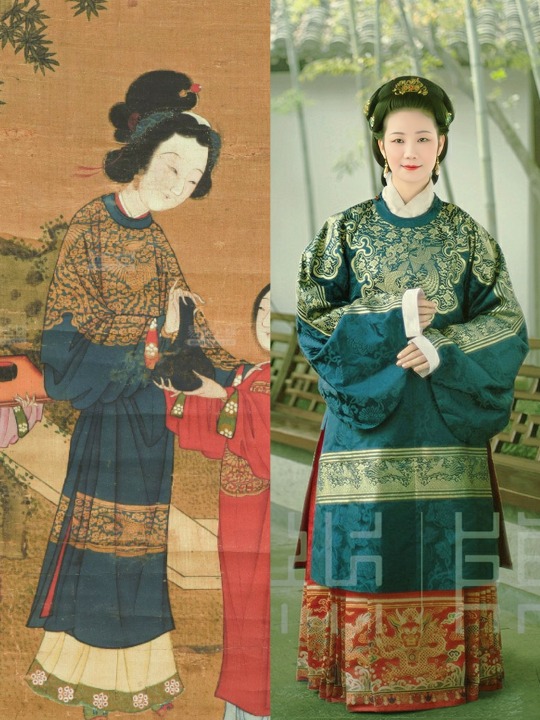
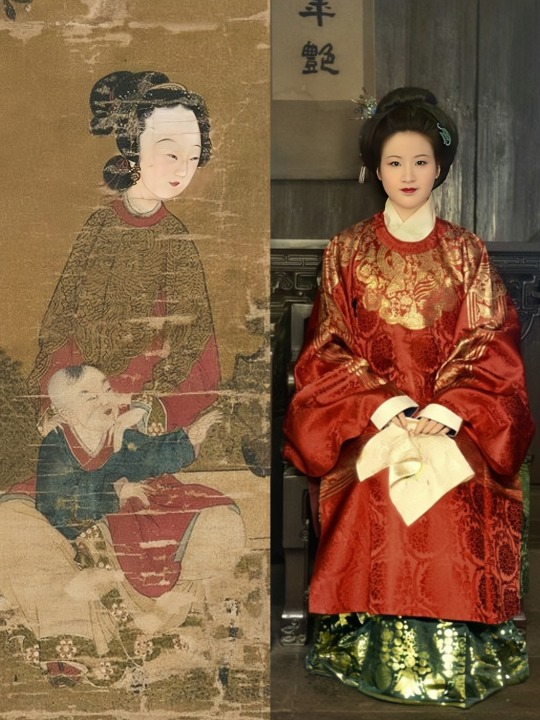

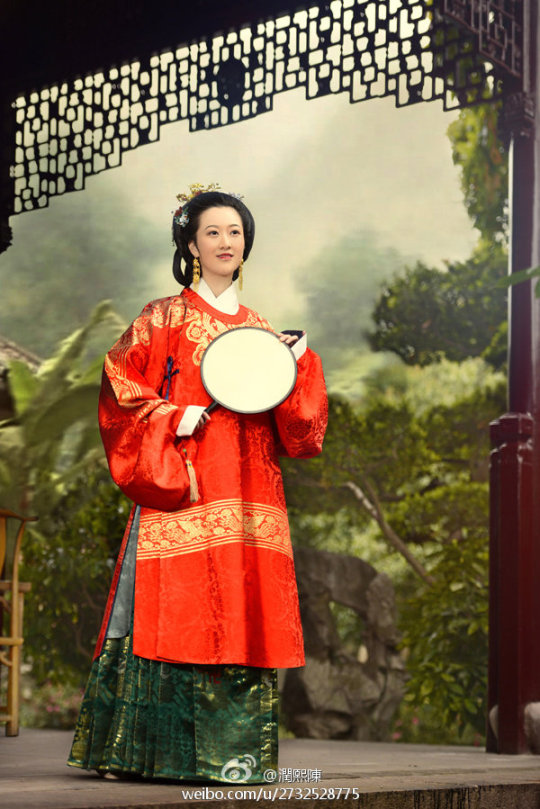






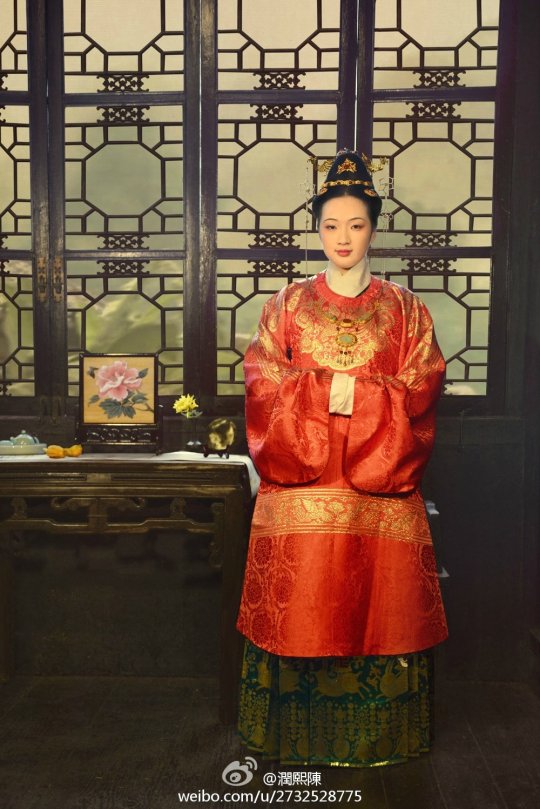

【Historical Artifacts Reference 】:
▶China Ming Dynasty Painting<The Beauty/仕女圖>,
Attributed to Tang Yin
唐寅(款)仕女圖

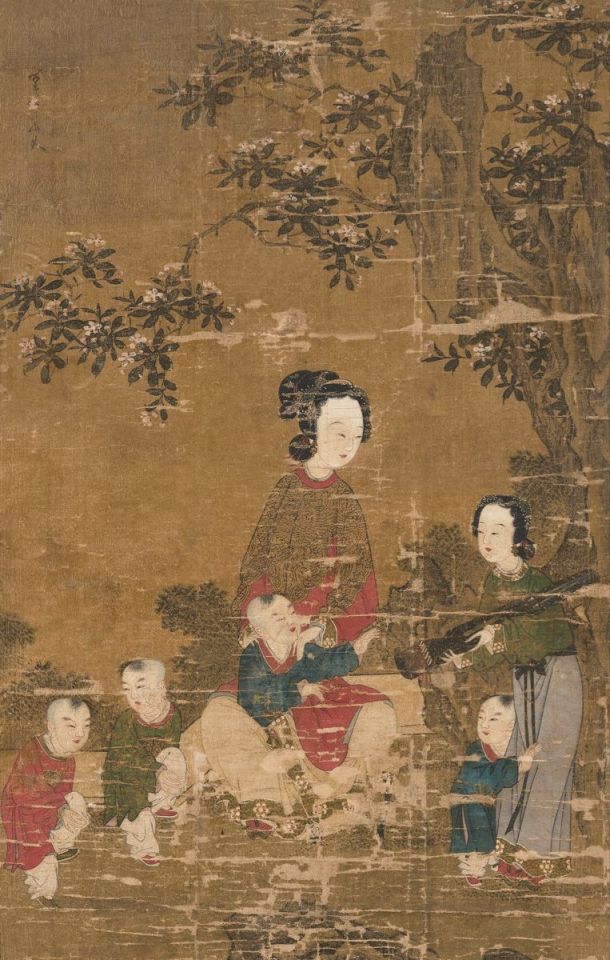
▶ China Ming Dynasty Hanfu Relics<绿罗织金凤纹袍/Green Luo Weave Gold Phoenix Gown>
Collection of Shandong Museum
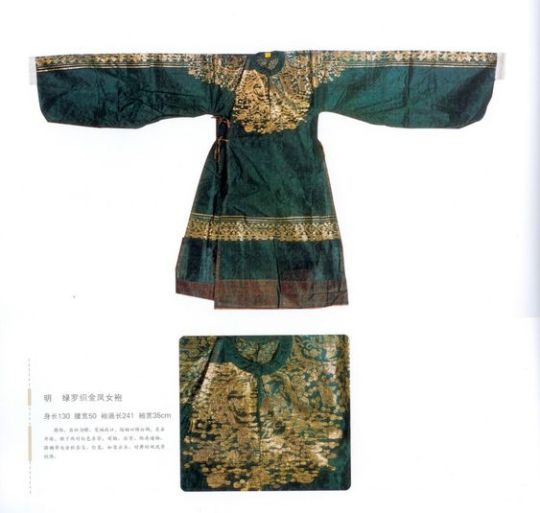
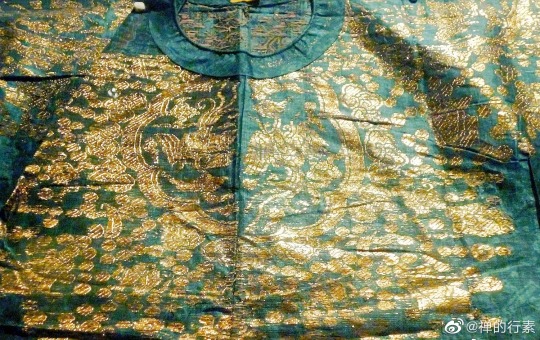
▶China Ming Dynasty Tomb of the Yueshan family in Zhixian,unearthed in 2004.
The picture shows the hostess of Tomb 1 wearing a gold-woven Di bird(翟鸟)robe
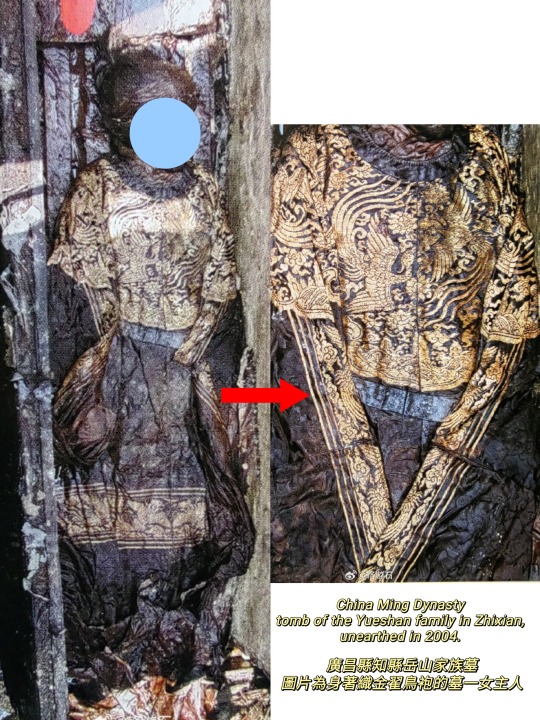
________________________________
Photo@潤熙陳(Weibo)
🔗 Weibo:https://weibo.com/2732528775/zxag2hdbh
________________________________
#chinese hanfu#ming dynatsy#hanfu#hanfu accessories#hanfu_challenge#chinese traditional clothing#china#chinese#Tang Yin#唐寅#hanfu historical relic#hanfu history#china historical fashion#chinese history
167 notes
·
View notes
Text

Chrysanthemum
Toshodai-Ji 唐招提寺
Nara, Japan
#photographers on tumblr#nature#flowers#pink#autumn#fall#floral#flores#otoño#crysanthemum#mums#toshodai ji#唐招提寺#nara#japan#original photographers#original photography#vertical
186 notes
·
View notes
Text
A gift
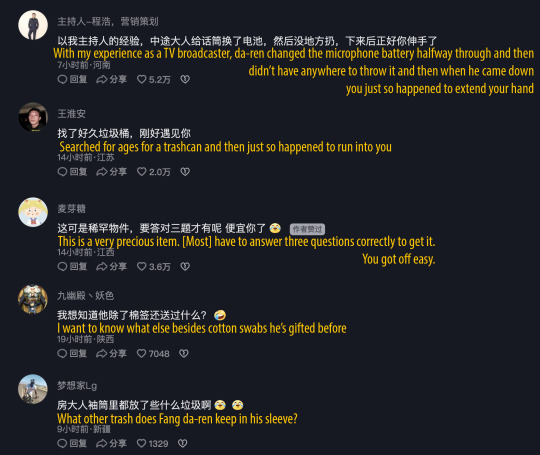
English added by me :)
#盛唐密盒#douyin#video#tiktok#blorbos from my [tang dynasty themed city block trivia game] show#fang da-ren is the one in purple and du da-ren is the one in red#side note the prize of answering their trivia questions correctly is whatever random junk fang da-ren decides to hand you
630 notes
·
View notes
Text

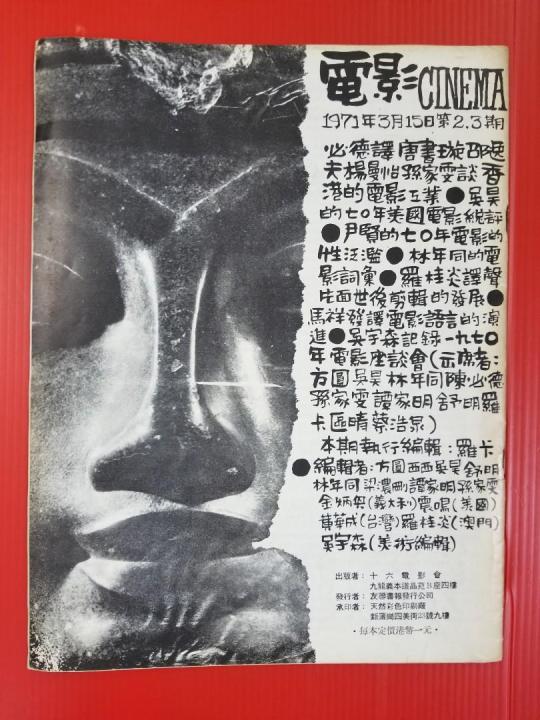
《電影》(月刊)2/3 合刊號
1971
69 notes
·
View notes
Text



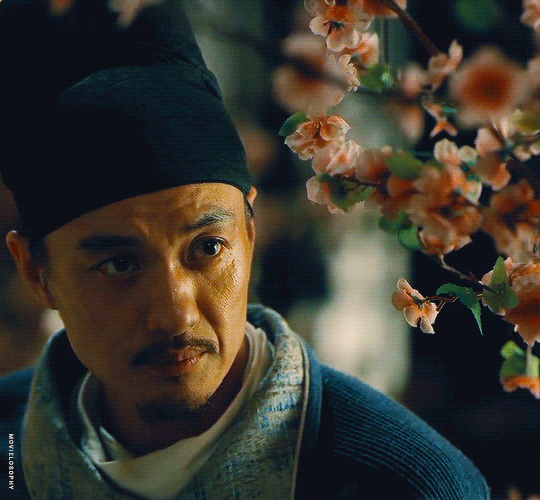
Judge Dee’s Mystery | Wow.
#judge dee's mystery#大唐狄公案#cdrama#zhou yiwei#character: di renjie#aesthetics#wang likun#character: cao an
90 notes
·
View notes
Text
by 小唐🍃 @ 374027659
79 notes
·
View notes
Text


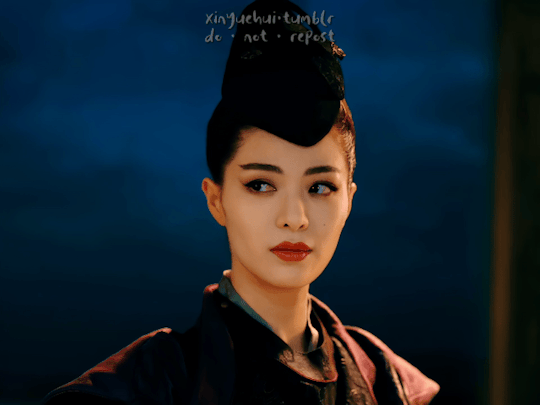
Wu Zetian · Judge Dee's Mystery (2024)
#大唐狄公案#judge dee's mystery#cdramasource#asiandramasource#dramasource#dailyasiandramas#chineseartistsinc#cdramanet#chinesemedia#cdramaedit#cdramagifs#chinese drama#cdrama#*4#wu zetian#zhong chuxi#ep4#姐姐们给个姬会吧!!#did anyone else saw this styling and screamed dongfang bubai anyways jokes aside#hello??? women 💖💖💕
56 notes
·
View notes
Text

Today’s lunch !
塩唐揚げとおむすび🍙
今日はぐっと寒くなりましたね!
ほくほくのご飯が食べたくなります。
ランチは、大好きなにんじんドレッシングを
色々アレンジして楽しみました!
120 notes
·
View notes
Text
[Hanfu · 漢服]Chinese Tang Dynasty (618–907AD) Traditional Clothing Hanfu Based On Tang Dynasty Dunhuang Mural







【Historical Reference Artifacts】:
▶ China Tang Dynasty Mural:<A female donor on the east wall of Cave 9 in the Mogao Grottoes, Dunhuang,Late Tang Period>
敦煌莫高窟晚唐9窟东壁女供养人

————————
📸Makeup photography:元奕泽
👩Model :扒皮
💄Makeup and styling:@化妆造型艺术家杨树云
💄Makeup Assistant:蔷薇 任凤
Teaching coordinator:葛南君
🔗Weibo:https://weibo.com/2660877923/Nq98uowv5
————————
#chinese hanfu#Tang Dynasty (618–907AD)#hanfu#hanfu accessories#hanfu_challenge#chinese traditional clothing#china#chinese#漢服#汉服#中華風#敦煌莫高窟晚唐9窟东壁女供养人#杨树云#hanfu history#hanfu girl#china history#chinese history#ancient china#artifacts
244 notes
·
View notes

